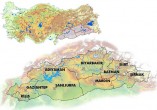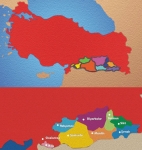Southeastern Anatolia Project (GAP)
Southeastern Anatolia Project (GAP), is the most comprehensive and cost-effective project for our history of Republic, and also applied most effectively between regional development plans and programs prepared so far. GAP is an integrated approach to regional development and sustainable human development in the international literature and philosophy and is a project that has a brand value.
The project area covers Euphrates-Tigris basin and 9 provinces located in the plains of Mesopotamia (Adiyaman, Batman, Diyarbakir, Gaziantep, Kilis, Mardin, Siirt, Sanliurfa, Sirnak). The area  and population size of provinces within GAP, is approximately 10% of Turkey.
and population size of provinces within GAP, is approximately 10% of Turkey.
The main goals of the GAP are to increase income level of the local people and life standards by using the resources they own, to split the difference between this Region and other regions, to contribute to the economic development and social stability targets at national level by increasing the productivity and the employment in rural area.
 In 1970s, the GAP was taken as a programme based on the development of water and land resources and it was planned to construct 22 dams, 19 hydraulic power plants and and irrigation networks for an area of approximately 1.8 million hectares for irrigation and hydraulic energy production in Euphrates-Tigris Basin. The total installed capacity of the project is 7476 MW and 27 billion kilowatt-hours of energy production was foreseen.
In 1970s, the GAP was taken as a programme based on the development of water and land resources and it was planned to construct 22 dams, 19 hydraulic power plants and and irrigation networks for an area of approximately 1.8 million hectares for irrigation and hydraulic energy production in Euphrates-Tigris Basin. The total installed capacity of the project is 7476 MW and 27 billion kilowatt-hours of energy production was foreseen.
With the Master Plan prepared in 1989, the GAP was transformed into a regional development project including agriculture, industry, transportation, education, heath, rural and urban infrastructure investments as well. The Project is based on sustainable humanitarian philosophy aiming at creating an environment in which the next generations could improve themselves; in this development the fundamental strategies of GAP are justice, participation, environmental protection, employment, spatial planning, infrastructure development, participation of public-private sectors and citizens to the investments.
Implemented as an integrated regional development project based on multi-sector, sustainable humanitarian development and aiming at increasing the competitive force of the Region, strengthening economic and social integration, the GAP has been planned with a visionary perspective including innovative approaches when considering the period it was prepared.

Comments are closed.